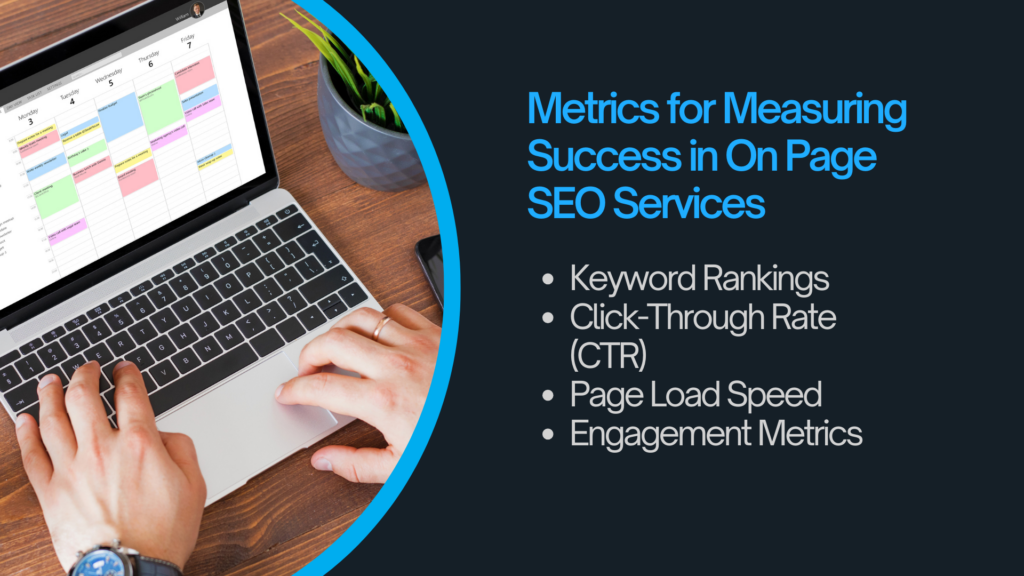If you’re running a business in today’s digital age, you’ve probably heard the term “on-page SEO services” thrown around a lot. What exactly does this mean for you, though, and why should you care? On-page SEO (Search Engine Optimization) is all about optimizing individual web pages to rank higher and earn more relevant traffic in search engines. It’s like setting up your shop window to attract customers.
While the Google algorithm is constantly evolving, Google remains committed to user experience. The tech giant always emphasizes the importance of creating “people-first content,” so continually updating your optimization strategies and making them user-friendly should be a top priority.
What Are On Page SEO Services?
On-page SEO refers to all the measures you can take directly within your website to improve its position in search rankings. This includes content quality, keyword optimization, and meta tags. Imagine it as the foundation of your digital marketing strategy. It’s where you lay the groundwork for attracting organic traffic. Here are a few factors to consider.
- Content quality. Your content should be informative and based on your target audience’s needs. High-quality content encourages users to stay on your site longer and engage with your offerings.
- Keyword optimization. This involves strategically using keywords related to your business throughout your content. It’s all about getting found for what you do.
- Meta tags. These are short texts that describe a page’s content and what readers would expect from it. Optimizing meta titles and descriptions can influence your click-through rates.
Continuous monitoring and improvement of these factors are important for your business. This strategy isn’t a one-and-done deal. It’s an ongoing process that needs attention. For businesses just starting out or seasoned ones needing a helping hand, consider partnering with an on-page SEO expert who can guide you through these efforts. Outsourcing these tasks can save you time and make sure you’re getting professional SEO services based on your needs.
Tools for Monitoring On Page SEO Services
Unlike off-page SEO services, such as backlink building and influencer marketing, this marketing method utilizes specific tools to improve optimization. And to effectively monitor it, you need the right “gadgets” in your toolbox. Here are some of the on-page tools that can help you track your progress.
Google Analytics
This powerful tool gives you insights into your website’s performance. You can track metrics like organic traffic, bounce rates, and average session duration. These metrics tell you how users are interacting with your content, so you can tweak your strategy accordingly. A high bounce rate might suggest your content isn’t meeting user expectations so it’s time to step it up.
Google Search Console
Think of this tool as your friend for understanding how Google views your website. It provides valuable data on your search performance, including clicks, impressions, and average position in search results. You can also identify issues that might prevent your site from ranking, like crawl errors or manual penalties. Regularly checking this tool helps make sure your site remains in tip-top shape.
SERP Tracking Tools
These tools, like SEMrush, Ahrefs, and Moz, help you keep tabs on your keyword rankings. You can see how your site stacks up against competitors and measure your visibility over time. Monitoring your keyword performance is important because if you notice a drop in rankings, it might be time to refine your content or rethink your strategy.
You can gain a clear picture of your effective page performance by leveraging these tools. If you’re a startup or a business that needs some extra hands on deck, consider outsourcing your SEO tasks. Professional services can provide the expertise and time-saving benefits you need to focus on growing your business while they handle the heavy lifting.
Metrics for Measuring Success in On Page SEO Services
Now that you have the tools, let’s talk metrics. Measuring success is about understanding how well your strategies are working. Here are some of the common metrics to keep an eye on to measure your success.
Keyword Rankings
This is a straightforward metric: how well your target keywords are ranking in search results. By tracking your keyword positions, you can assess the effectiveness of your optimization efforts. If you’re climbing the ranks, congratulations! If not, it may be time to tweak your keyword strategy.
Click-Through Rate (CTR)
This rate is the percentage of people who click on your link after seeing it ranked in search results. A high CTR means your title and meta description are compelling and relevant to searchers. If your CTR is low, revisit your titles and descriptions to make them more engaging to readers.
Page Load Speed
Did you know that a slow-loading page can impact your rankings? Google considers page speed a ranking factor, so it’s important to keep your site running smoothly. Use tools like Google PageSpeed Insights to measure your load times and get suggestions for improvements.
Engagement Metrics
Metrics such as bounce rate, average session duration, and pages per session can provide insights into how users interact with your site. If users are bouncing quickly, it might indicate that your content isn’t meeting their needs or expectations. A good strategy should keep users engaged and encourage them to explore further.
Tracking these metrics will give you a clear picture of how your page is performing. For businesses looking to optimize their strategies, remember that it’s not just about the numbers but about interpreting what they mean for your business success. Regularly review your metrics and adjust your approach based on what you learn.

Best Practices for Monitoring On-Page SEO
To wrap up your monitoring efforts, consider implementing these best practices.
1. Regularly update and audit your content
Keeping your content fresh and relevant is key to engaging your audience and improving your search rankings. Schedule regular content audits (perhaps quarterly or biannually), so your information is accurate, up-to-date, and engaging.
If you have blog posts that mention statistics or data, check to see if those figures are still valid. If they’ve changed, update your content with the latest information. This not only improves the quality of your content but also signals to search engines that your site is active and authoritative.
2. Implement A/B testing
A/B testing, or split testing, is an invaluable practice for optimizing your website. By experimenting with different headlines, images, or content layouts, you can determine what resonates best with your audience.
If you’re unsure whether a question or a statement works better as a headline, create two versions of the same page, one with each headline. Monitor which version has a higher click-through rate (CTR) and engagement level. This data-driven approach allows you to make informed decisions about your content and makes sure that you’re capturing your audience’s attention.
3. Create a reporting schedule
Setting a timeline to review your performance regularly helps you stay on top of changes and trends. Consider creating a monthly or quarterly reporting schedule to analyze key metrics such as organic traffic, bounce rates, and keyword rankings.
If you notice a sudden drop in organic traffic, your report can help identify which pages were affected and why. You can quickly address issues and refine your strategies with this approach. Tools like Google Data Studio can help you create visually appealing reports that summarize your performance at a glance.
4. Monitor your competitor’s performance
Keeping an eye on your competitors can provide valuable insights into your own strategies. Tools like SEMrush or Ahrefs help you analyze competitor keywords, backlinks, and content strategies. By understanding what’s working for them, you can identify gaps in your own strategy and discover new opportunities to optimize your content.
If a competitor ranks well for a keyword you hadn’t considered, you might want to create content targeting that keyword to improve your own rankings.
5. Utilize your user feedback
Engaging with your audience through surveys or feedback forms can provide insights into how users perceive your website. You might discover that visitors find your navigation confusing or that they’re looking for content you haven’t yet provided. Use this feedback to make necessary adjustments, so that your site not only ranks well but also meets user expectations.
By regularly updating your content, leveraging A/B testing, maintaining a consistent reporting schedule, monitoring competitors, and utilizing user feedback, you’ll create a robust strategy that adapts to ever-changing trends and user needs.
Remember, SEO is not a one-time task but a continuous business in itself that requires attention and adaptation. For businesses seeking to improve their online presence, consider partnering with a professional who knows different types of SEO services like the on-page. By doing so, your on-page strategies are optimized for success while freeing up time to focus on other aspects of your business.
Take Your On-Page SEO Services to the Next Level
Optimizing your page is an ongoing journey, not a one-time task. Monitoring and measuring your efforts with the right tools and metrics are important for your business success. By keeping an eye on your performance and making data-driven adjustments, you can continually improve your rankings and visibility.
So, if you’re ready to level up your SEO game, don’t hesitate to leverage the tools and metrics discussed here. And remember, if you’re feeling overwhelmed or need expert help, outsourcing your SEO services can be a game changer. Contact us at All In Outsourcing, and let our services take care of the nitty-gritty while you focus on what you do best: growing your business!
